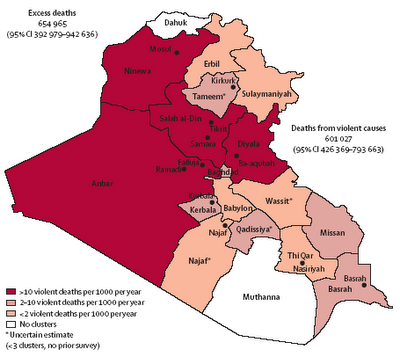
Deaths due to violent sources per Governorate. Source: The Lancet.
A startling study (pdf) published today in The Lancet, a highly respected British medical journal, estimates that 601,027 Iraqis have died of violent causes since the 2003 invasion, and that there have been 654,965 excess Iraqi deaths in the same time period. The study was conducted by Gilbert Burnham, Riyadh Lafta, Shannon Doocy and Les Roberts. Burnham, the lead author, is an epidemiologist at the Johns Hopkins Bloomberg School of Public Health.
The study estimate, based on household interviews, is dramatically higher than the death toll reported by other organizations, such as Iraq Body Watch, which are based on passive surveillance methods like monitoring newspaper accounts. The authors note:
Our estimate of excess deaths is far higher than those reported in Iraq through passive surveillance measures. This discrepancy is not unexpected. Data from passive surveillance are rarely complete, even in stable circumstances, and are even less complete during conflict, when access is restricted and fatal events could be intentionally hidden. Aside from Bosnia, we can find no conflict situation where passive surveillance recorded more than 20% of the deaths measured by population based methods. In several outbreaks, disease and death recorded by facility-based methods underestimated events by a factor of ten or more when compared with populationbased estimates.
The death rate found in this study compares favorably with data collected by the Department of Defense itself (via the Multi-National Corps-Iraq), according to a figure in the study report in which the death rates estimated for the May 2004 to May 2005 and the June 2005 to June 2006 periods are virtually identical to those of the household survey. But it is not clear from the report where the DoD data was obtained. The study estimate implies nearly 700 violent deaths per day in Iraq, but the MNC-Iraq estimates only 117 violent civilian deaths per day. The DoD estimate is based only on violent deaths in incidents to which coalition troops respond.
Data from all surveys show a dramatic increase in the Iraqi death rate, which has virtually doubled from 2005 to 2006. Deaths attributable to coalition forces account for 31% of violent deaths, according to the household survey, and the authors note that:
Most violent deaths were due to gunshots (56%); air strikes, car bombs, and other explosions/ordnance each accounted for 13–14% of violent deaths. The number of deaths from gunshots increased consistently over the post-invasion period, and a sharp increase in deaths from car bombs was noted in 2006.

Trends in number of deaths reported by the Iraq Body Count and the MultiNational Corps-Iraq and the mortality rates found by this study. Source: The Lancet.
The authors note that the mortality rate estimates, which have more than doubled since the invasion, meet the Sphere standards for a humanitarian emergency, concluding that, "We continue to believe that an independent international body to monitor compliance with the Geneva Conventions and other humanitarian standards in conflict is urgently needed."
No comments:
Post a Comment